Scheherazade is without a doubt my absolute favourite piece of classical music. It’s packed with passion and sensuality in spades as it journeys through an utterly captivating story. And what a ride of heavenly and hellish contrasts! You’ve got hellfire dynamics and the menacing sultan’s theme. Then there’s the tempestuous storms at sea, the shipwreck being crashed into the cold, hard, jagged rocks and the visceral splitting of the ship’s timbers. All of which contrasts with the most delicious violin and harp representing the utterly sensuous, captivating, intoxicating beauty of the queen Scheherazade. Seriously, it’s impossible to put it into words in a way that does it justice – you just have to hear it, to feel it.
Admittedly, I’ve probably heard it and felt it more than most – and I’ve amassed quite a collection of versions in various formats over the years. I have three official 15ips 2-track releases: (1) the Analogue Productions Ultra Tape of arguably the definitive recorded Scheherazade: the 1960 Reiner / Chicago Philharmonic RCA recording; (2) the Giulio Cesare Ricci mastered Foné recording of Gianandrea Noseda conducting the Filarmonica Teatro Regio Torino which I previously reviewed here, and now (3) this new Chasing The Dragon release. I also have a couple of 7.5ips 4-track tape releases: the 1958 Beecham / Royal Philharmonic Orchestra and the 1969 Ozawa / Chicago Symphony Orchestra, both on the Angel label.
In addition to these five tape versions, I also have more than a dozen on vinyl. Of those, my favourite is probably the Kondrashin / Concertgebouw 1980 on Phillips, which also features my favourite artwork – the beautiful illustration by Danish illustrator Kay Neilsen, whose limited edition book, ‘1001 nights’, I also have in my Scheherazade collection.
Anyway, on to the newest acquisition from Chasing The Dragon… I’m going to hand over to hi-fi journalist Neville Roberts who was lucky enough to be present for the recent recording session, and who brings us some fascinating insights from the day.
Neville Roberts reports from London!
 It was a bright, overcast but dry day at the end of May 2023 when I arrived at The Henry Wood Hall to attend another recording session by the British audiophile recording company Chasing The Dragon. The man behind Chasing The Dragon, Mike Valentine, had once again kindly invited me to this wonderful venue. The previous time was for the recording of Mendelssohn’s Octet in 2022, and this time it was for his recording of Rimsky-Korsakov’s well-known symphonic suite, Scheherazade. The music was performed by The National Symphony Orchestra under the baton of Anthony Inglis, and led by the award-wining violinist Katerina Nazarova.
It was a bright, overcast but dry day at the end of May 2023 when I arrived at The Henry Wood Hall to attend another recording session by the British audiophile recording company Chasing The Dragon. The man behind Chasing The Dragon, Mike Valentine, had once again kindly invited me to this wonderful venue. The previous time was for the recording of Mendelssohn’s Octet in 2022, and this time it was for his recording of Rimsky-Korsakov’s well-known symphonic suite, Scheherazade. The music was performed by The National Symphony Orchestra under the baton of Anthony Inglis, and led by the award-wining violinist Katerina Nazarova.
The music – Scheherazade Op. 35
Scheherazade Op. 35 is one of Rimsky-Korsakov’s most popular works and is a symphonic suite composed in 1888 and based on One Thousand and One Nights (also known as The Arabian Nights). One Thousand and One Nights is a collection of Middle Eastern folk tales collected over many centuries and compiled in Arabic during the Islamic Golden Age. The story revolves around the fictional Persian Sultan Shahryar, who was betrayed by his first wife, which led him to believe that all women would ultimately betray him. Shahryar then resolved to marry a new virgin every day and to have her beheaded the next morning before she could dishonour him. This continued for three years until he married Scheherazade.
Scheherazade was an intelligent woman, and for 1,001 nights she told Shahryar a story, timing it so that she stopped in the middle just as dawn was breaking. This way, Shahryar had to keep her alive for another day so that she could complete the story the following night. After 1,001 stories, Scheherazade tells Shahryar that she has no more stories for him, but by that time, Shahryar has renewed his trust in women.
The symphonic suite Scheherazade consists of four related movements, written to produce a sensation of fantasy narratives from the Orient. This orchestral work combines an interest in the East and orientalism with an energetic and colourful orchestration of the stories, which were typical of Rimsky-Korsakov. The suite as a whole is unified by the repetition of two themes, one representing the Sultan and the other representing Scheherazade.
Each of the sections of the first movement, ‘The Sea and Sinbad’s Ship’, are highly distinctive, but aspects of the main melodies keep the whole movement cohesive. Shahryar’s stern and menacing theme is heard first, played on the trombone, tuba, strings and lower woodwind. Scheherazade’s clear and musical theme follows on the solo violin (played by Katerina Nazarova on this recording) accompanied by the harp. The music then fills out to convey an impression of the swell of the sea and ends with a return of Shahryar’s theme leading to a climax played by the whole orchestra.
The second movement, ‘The Kalandar Prince’, reprises Scheherazade’s theme, but with the bassoon taking charge to present the Prince’s tale. The movement takes us through a variety of moods, ranging from the pathetic to the mock-heroic, before the tempo gathers momentum with brass fanfares played on the trombone and trumpet. The gentle third movement, ‘The Young Prince and The Young Princess’, is a romantic idyll set in an oriental garden at twilight. The clarinet accompanied by percussion plays the Princess’ theme, while the Prince’s theme is picked up by the violins. The return to the Sultan’s theme at end of the movement is a reminder to us that it is still Scheherazade speaking.
The final movement, ‘Festival at Baghdad’, ties in aspects of all the preceding movements, including a reprisal of previous themes and an orchestral composition suggesting a fierce storm culminating with a climax representing a shipwreck. Things quieten down and the movement ends with the solo violin to remind us of Scheherazade, bringing the suite to a lyrical and peaceful conclusion.
The National Symphony Orchestra
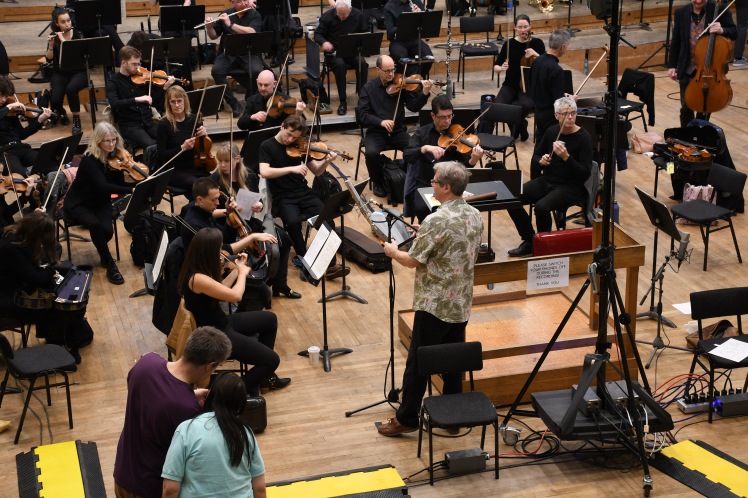
The National Symphony Orchestra was founded in the 1940s, at which point it was recording an average of 10 albums a year for Decca with famous conductors and soloists. Throughout World War II almost all of the NSO’s musicians were active personnel, so unlike many other orchestras, which relied on musicians who were either too old or otherwise unfit for military service, the orchestra was composed of young men. The records made between 1944 and 1946 are considered by experts to be outstanding, especially when compared with those of pre-war orchestras.
From the 1980s, the reputation and standing of the orchestra surged forwards, successfully performing and recording for audiences in a dynamic range of genres – classical, film and TV scores, West End and Broadway musicals – and attracting celebrated international singers, all of which it does to this day. The orchestra continues to demonstrate consistent commitment and passion and is admired for both its versatility and its ability to communicate and connect with audiences. It has recently found renewed energy and direction under its Managing Director, Justin Pearson, who is also the orchestra’s lead cellist.
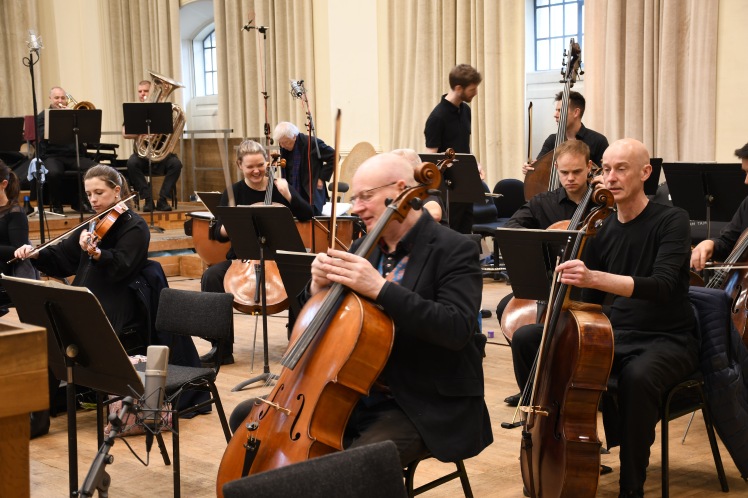
The conductor – Anthony Inglis
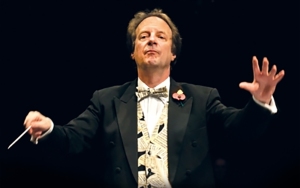
Anthony Inglis is currently the music director of The National Symphony Orchestra and is one of Britain’s most popular conductors. He leads a busy international conducting career, appearing with some of the greatest orchestras in concert halls from Sydney via Tokyo, to the Concertgebouw in Amsterdam, and has recorded in studios around the world. He has conducted more times at London’s Royal Albert Hall than anyone else and is well known in the UK for conducting Classical Spectacular. Inglis and The National Symphony Orchestra perform annually on Cunard’s RMS Queen Mary 2 for the Last Night of the Cunard Proms Cruise.
The leader – Katerina Nazarova
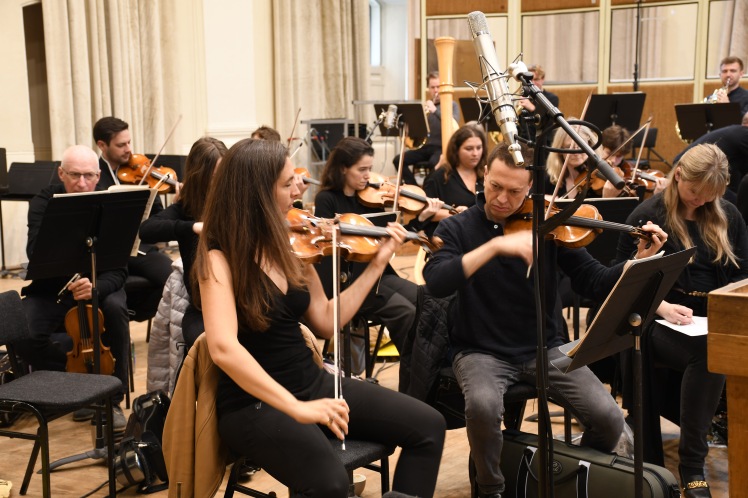
Born in Tasmania, Katerina Nazarova began playing the violin and piano at a very early age and made her solo debut at age 11 with the Tasmanian Symphony Orchestra. She gained a First Class Honours Bachelor of Music degree in 2007, a Master of Music in Advanced Performance with Distinction from the Royal College of Music in 2009 and an Artist Diploma from the Royal College of Music in 2010.
She has been awarded a wealth of prizes and scholarships, including the Grand Prize at the ABC Symphony Australia Young Performers Awards in 2012, and was a prize-winner in the 2015 Royal Overseas League Competition.
The violin played by Nazarova was the famous violinist Arthur Grumiaux’s 1739 Guarneri del Gesù ‘Il Museo’, which was loaned to her for this recording.
The Henry Wood Hall
The Henry Wood Hall is an orchestral rehearsal and recording studio in Trinity Church Square, Southwark, London. It’s London’s first purpose-built home for orchestral rehearsals and is named after the conductor Sir Henry Wood.
The recording session
In order to record a full orchestra as an all-analogue audiophile recording, two ELAM 251 valve microphones fitted with premium-quality 6072A valves were used as a spaced pair, with a Jecklin disk placed between them for the main stereo feed. This stereo feed was recorded on ½-inch tape with a Studer A820 recorder running at 30ips. The tape used was Recording The Masters SM900 high output premium quality tape.
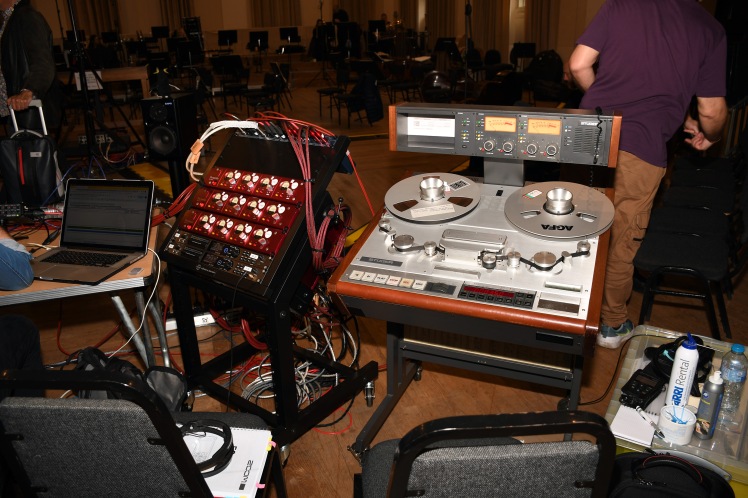
Other microphones, including a Neumann U47 valve microphone, two Neumann TLM 67, five Flea 12 (AKG C12) fitted with premium-quality 6072A valves, two Neumann U89 microphones and a Neumann KU-100 dummy head for a binaural recording were also used, and these microphones were recorded by Zoom and Tascam professional digital recorders. Audiophile quality cabling, rather than normal studio-quality cabling, was used throughout. Vovox cables were fitted between the valve microphones and their power supplies in place of the supplied cables. Over 9m of Nordost Odin 2 and Zensati Zorro XLR cables were connected between the microphones and the mixers.
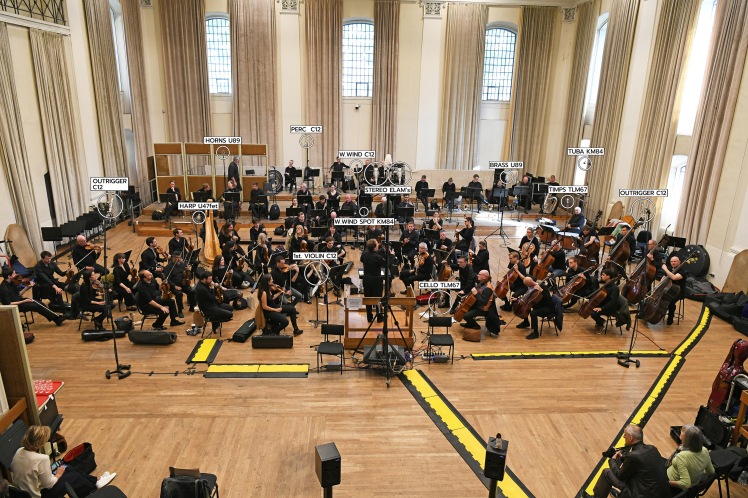
In addition to the copy-master tape and digital download, the recording has been mastered at AIR Studios in London to produce an LP on a Neumann VMS 80 cutting lathe. A precision technique known as half-speed mastering was used, which requires the source to be played at half speed and the cutting lathe to run at half speed on the specially adapted Neumann VMS-80 lathe at AIR Studios. This process converts the high-end frequencies into relatively easy-to-cut mid-range frequencies in order to produce a cut with an excellent high frequency response and very solid and stable stereo images.
The recording quality
As at other recording sessions that I’ve attended, I was able to listen to the recording on headphones and then remove them to be able to hear the music live. This gives me a useful reference to assess the copy-master tape.
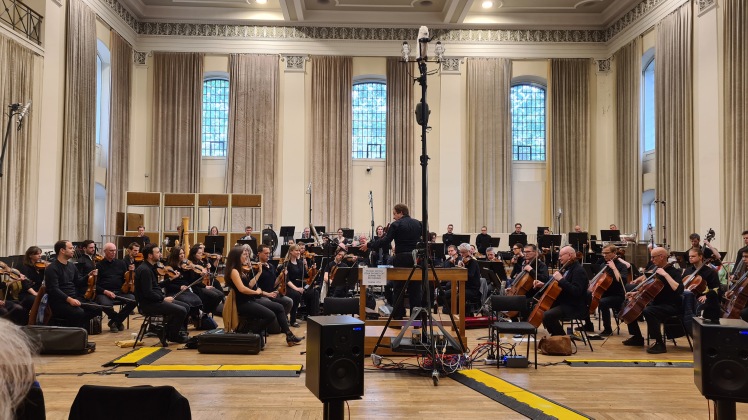
I can honestly say that this is the best recording of Scheherazade I’ve ever heard – and I’ve heard many over the decades! In fact, it’s been one of my favourite pieces of music ever since I was in my early teens. Firstly, the performance somehow manages to impart a freshness to the music that’s somehow missing from others I’ve heard. The power and energy from the National Symphony Orchestra is really captivating. There was a lovely rapport between the orchestra and Inglis, and this certainly comes across in the recording. The sprightly fourth movement really shows off the energy of the performance and the clarity, depth and realism of the recording is truly wonderful. Also, Nazarova’s violin playing is exceptional and her solo playing, especially during the opening of the second movement and the conclusion of the fourth movement, is totally captivating.
Overall, the dynamic range, instrument positioning and overall sound quality is exactly as I remembered at the live recording. Chasing The Dragon use Recording The Masters high output premium quality professional tape for the copy masters and obviously there is no audible tape hiss. Each of the musicians, especially the lead violin and cello, occupy their own identifiable space within the sound stage and the complexities of all the individual instruments are easily distinguishable. The master analogue to analogue tape copy is really as close as you’ll get to the live performance. This is another brilliant Chasing The Dragon recording that will doubtless gain the reputation of being a reference recording of this wonderful and popular piece of music.
The copy-master tapes of the album, which are made to order, can be purchased directly via the Chasing The Dragon website www.chasingthedragon.co.uk/copymastertapes.html at the cost of £400 for a ¼” 15IPS copy-master tape.
…and back to Dave at home!
So, for Neville’s money this is “the best recording of Scheherazade ever heard”. I couldn’t wait to dive in and find out if I’d agree.
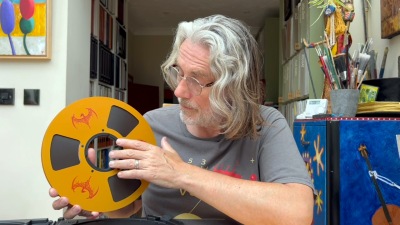 Having spent many, many hours with so many different versions, for me there are two main considerations here, each of which probably carries an equal rating: the musical event itself, combining the conductor’s interpretation and the orchestral performance, and the recorded sound quality. Obviously each of these parameters is far from simple and each one has a raft of underlying elements to unpack. But for the sake of wrapping things up here following Neville’s insights, I’ll keep my own conclusions quick and simple.
Having spent many, many hours with so many different versions, for me there are two main considerations here, each of which probably carries an equal rating: the musical event itself, combining the conductor’s interpretation and the orchestral performance, and the recorded sound quality. Obviously each of these parameters is far from simple and each one has a raft of underlying elements to unpack. But for the sake of wrapping things up here following Neville’s insights, I’ll keep my own conclusions quick and simple.
As I’ve already mentioned, the Reiner / Chicago Symphony Orchestra performance is a major reference point, and one which many commentators would list as the number one, the definitive Scheherazade, and I can certainly see why. That performance, and its recording, are without doubt passionate, full-bodied and deliver a rollercoaster hell-for-leather ride through the emotions. I’ll always give it ten out of ten, there’s no question of that.
My other personal favourite, the 1979 Phillips Kondrashin recording, is jaw-droppingly beautiful. It’s also twenty years younger than the RCA recording and that shows, such that the clarity and purity of the recording make up for a perhaps slightly less robust, hell-for-leather performance.
So, how does the Chasing The Dragon fit into the mix? Well, let’s cut to the chase here: it sounds incredible. But let’s unpack those two main considerations a bit more. First, the musical event. I personally won’t say it’s the best performance ever but it’s certainly a very, very good one. You can listen from beginning to end and be completely ‘lost’ in the music throughout. Purely as a performance, I’d put this in my top three or four.
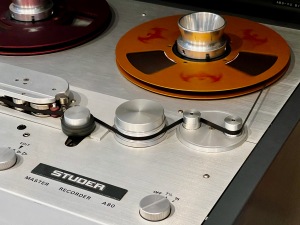 However, my experience of this tape it goes far beyond that, which is where the second main consideration comes in – the recording quality. So, let’s also evaluate this on purely audiophile grounds: how does it actually sound? In a word: stunning! The clarity, the unforced yet tremendous dynamics, the separation of each strand of the music is unparalleled in my opinion. Not by a small amount either.
However, my experience of this tape it goes far beyond that, which is where the second main consideration comes in – the recording quality. So, let’s also evaluate this on purely audiophile grounds: how does it actually sound? In a word: stunning! The clarity, the unforced yet tremendous dynamics, the separation of each strand of the music is unparalleled in my opinion. Not by a small amount either.
In terms of delivering the full sense of clarity and presence, and a felt experience of sitting in front of an orchestra performing this masterpiece, nothing else comes even close. For sure the Reiner sounds more ballsy, but the recording is also more murky. Where the great crescendos thunder with dark menace on the Reiner, all of the individual textures shine through on the Chasing the Dragon: tympanis, basses, horns – each instrument absolutely explodes out into the Henry Wood Hall, all sounding incredibly real. With the direct copy of the master tape, you really do experience that awesome power and majesty. Yet, even in the midst of such power, the tiniest sounds still break through with impeccable clarity. Imagine hearing the tiniest triangle ‘ting’ amidst a thunderous thunderclap of biblical proportions – it’s pretty mind-blowing – kind of like looking through a telescope and a microscope at the same time and getting to perceive both the macro and the micro in complete detail.
The feeling of space is palpable. To use another visual metaphor, you can ‘see’ the hall and the whole orchestra. From the tiniest sound, through the most sweet and seductive solo, to the most thunderous crescendo, that piercing clarity remains, each time triggering a visual impression as well as a sonic one. It’s a hi-fi triumph and, as such, any budding audiophile should hear this. If you’re not able to play tape, don’t worry, the recording is being made available on vinyl, on 24/192 and DSD downloads.
You’ll find them all at www.chasingthedragon.co.uk
PS. If you have room for a bit more rambling on this one (including about 3 minutes of the tape playing on my system – only ‘recorded on iPhone’ sound quality of course, but you can get a feel of the performance) – check out this YouTube video.






